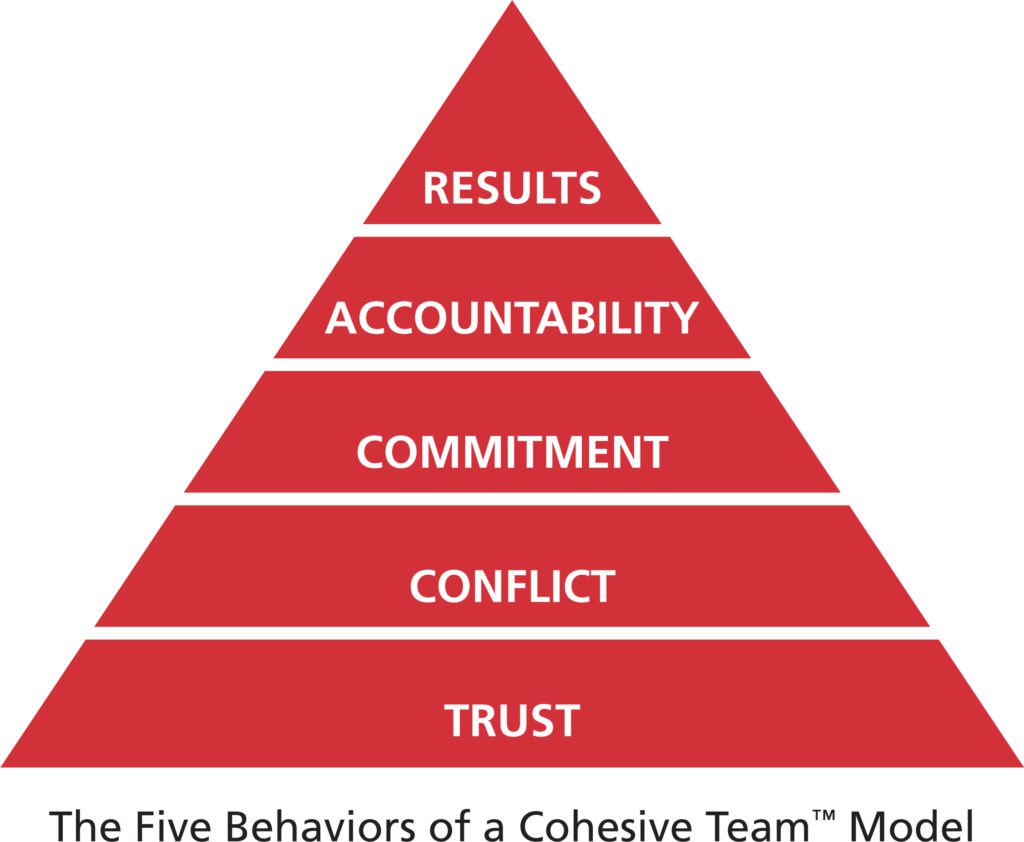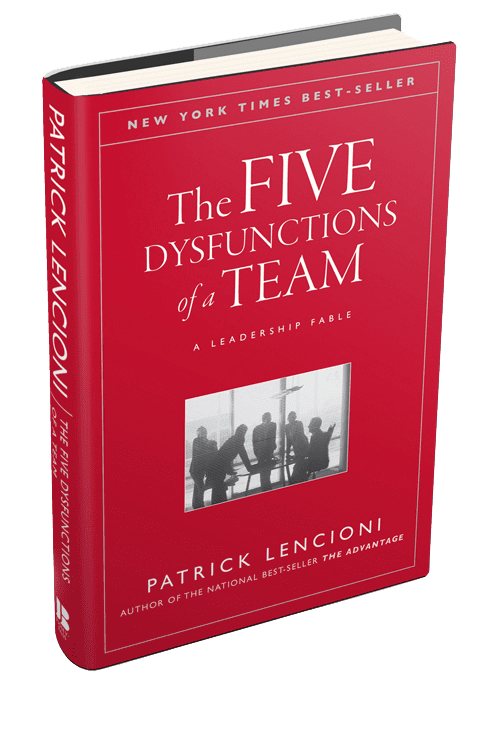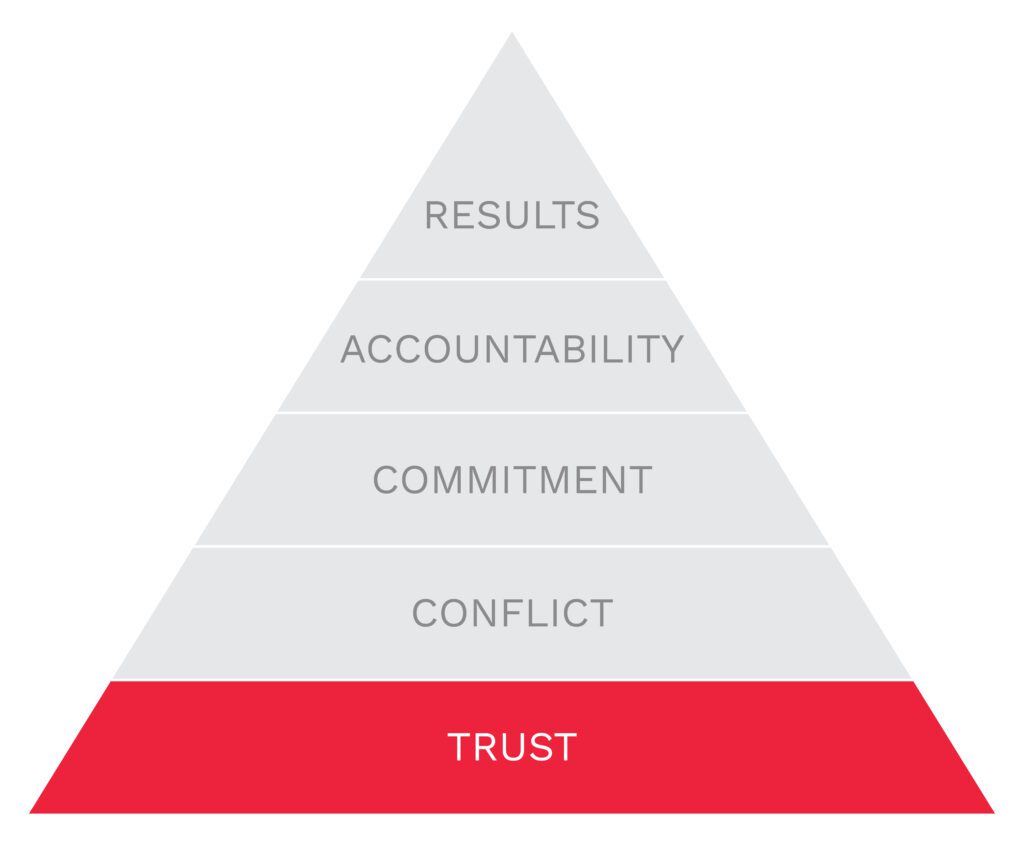Office hours
- Mon - Thurs: 9AM - 5:30PM ET
- Friday: 9AM - 4:30PM ET
If you loved The Five Dysfunctions of a Team fable, you will love the Five Behaviors of a Cohesive Team™ training program based Patrick Lencioni’s best-selling book.
The Five Behaviors training program provides the same framework from the book. Teams start their journey by learning how to instill vulnerability-based trust. They build on that trust by learning how to engage in productive conflict. This unfiltered, constructive debate on ideas increases the team’s ability to commit to decisions and hold each other accountable. They conclude their journey by learning how to achieve collective results.

This program is designed to address team dysfunction, improve team productivity, and help individuals learn how to work together effectively, giving teams an edge on their competition.
The training combines behavioral insights from DiSC to influence the discussions that take place within each step in the model. As an example, when teams talk about conflict, each team member’s personalized report tells them how their DiSC style may tend to perceive and navigate conflict. This helps make conversations more open and rich.

Read our summary of Patrick Lencioni’s Five Dysfunctions of a Team. In this summary, you will learn who the main characters are and what happened on their team. Most importantly, the summary covers how the 5 Dysfunctions model connects to the fable portrayed in the book.
Team members begin with a brief assessment to gain insights about themselves and their approach to teamwork. They take these insights to a virtual or classroom training to work strategically through each behavior, building the skills they need to form stronger teams.

The Five Behaviors model takes the shape of a pyramid. Teams will begin at the bottom of the behavior pyramid, slowly building a foundation to support each subsequent skill through targeted activities and group discussions.
The training program works participants through each of the five stages of the model in steps. In both the Team and Personal Development programs, participants will begin by building Trust.
Before learners can practice productive conflict or learn to achieve better results with their teams, they must first spend time discussing how to achieve vulnerability-based trust with each other.
What is vulnerability-based trust? We’ll let Pat explain how vulnerability-based trust can transform your teams. Check out his short video to learn more.
For new teams or groups of up to 30 People.
The Five Behaviors Personal Development program teaches individuals how to be more effective teammates. When employees better understand themselves, they can work more effectively on any team. This training program gives individuals the skills they need to be the best team player they can be on every team they’re in.
Designed for intact teams of 5-12 People.
The Five Behaviors Team Development program focuses on helping intact teams overcome specific issues that are holding back their performance. They will learn to better understand themselves and how they can work effectively together. Team members will rate how the team is doing with each behavior and can re-assess their progress any time.
The Five Behaviors Personal Development profile offers learning professionals, coaches, and trainers a unique way to use Pat Lencioni’s model to help individuals recognize how they can contribute towards any team. This program also works well as a way to onboard new team members and employees into the company’s cohesive team-based culture. Use this program with new teams or project teams who only work with each other occasionally.
For small to medium-sized intact teams, The Five Behaviors Team Development program is the best option to improve teamwork. This program can be used with dysfunctional teams or teams who want to take their work to the next level. It’s also a great follow-up for individuals who already previously completed the Five Behaviors Personal Development program, helping them to contextualize the model on their intact team. Use this program with established teams who work with each other every day.
Our online Five Behaviors facilitator certification covers both programs!
Five Behaviors Individual Report – In both the Team and Personal Development programs, all participants will take an assessment and receive a personalized report. This report combines the insights of DiSC with the Five Behaviors model. These reports can be purchased through our website or issued through an EPIC Account.
Five Behaviors Facilitation Kit – The Five Behaviors training materials will standardize how your organization conducts these trainings. These materials provide a strong foundation to ensure you run a high quality and impactful training every time. The kit provides access to activities, PowerPoint slides, videos, and a fully scripted leader’s guide. While owning a facilitation kit is not required to use the Five Behaviors assessments and reports, the materials are invaluable for organizations that want to run these programs with multiple teams and for coaches who want to add this program to their tool kit.

Get started with the Five Behaviors using the digital facilitation kit, which includes both the Personal Development and Team Development training programs. Both programs use the framework developed by Patrick Lencioni in his best-selling book, The Five Dysfunctions of a Team. Teams and individuals will receive personalized results that will help them implement the concepts of Trust, Conflict, Commitment, Accountability, and Results to make impactful and lasting changes.
Certification is not required to facilitate the the Five Behaviors Team or Personal Development training programs. The Facilitation Materials available for each program are designed so that an experience L&D professional, coach, or trainer can run the program right from the box. However, we offer a Five Behaviors of a Team online certification program that will prepare you to run either training program.
In this course, training professionals will complete online, self-directed work and participate in live, instructor-led sessions. The course is designed to help facilitators feel comfortable running both the Team and Personal Development programs and learn how to keep the training alive after a team’s training is complete. The registration fee for this course includes your choice of the Five Behaviors Team or Personal Development facilitation kit.
Comparison Reports are a great tool to use to help team members learn more about one another and improve their individual relationships and, by extension, their ability to work together. Based on data from the personality items in The Five Behaviors assessment, the reports are organized around The Five Behaviors model and illustrate two continua per behavior. Whether introducing new teammates, helping to build rapport, or working to resolve an interpersonal conflict, Comparison Reports can be a great addition to a Five Behaviors program. The best part is that these reports are free to use if you have an EPIC account.
Progress Reports (Team Version Only) – The goal of any Five Behaviors Team Development program is to help teams become more effective. Progress reports will now help teams measure their improvements. Changing behaviors and habits take time, and we encourage trainers to use these reports as a follow-up for the initial training that was conducted. This way, teams can revisit the content while also being able to talk about what improvements they have seen and what areas still need work.